Preschool Rhythm Activity Cards for Engaging Piano Lessons
This post may contain affiliate links. If you purchase something through an affiliate link, I will receive a small commission at no cost to you. For more information, read the disclosure statement here.
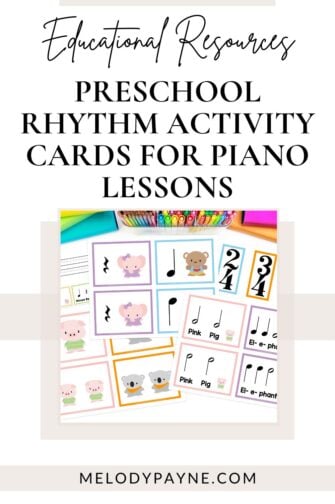
These preschool rhythm activity cards are my go-to cards for teaching rhythmic values and time signatures to all of my preschool piano students.
Have you ever been approached about teaching a 4-year-old piano student but the prospect of filling a 30-minute private piano lesson for a preschooler seemed daunting? I was in this exact situation about 11 years ago.
I’ll never forget my very first preschool piano student, a 3 1/2-year-old boy named Charlie who transformed my view of teaching piano to preschoolers.
I will always be grateful to his mom Danielle, an elementary school teacher who allowed me the grace and space to experiment with different teaching strategies.
That being said, I really could’ve used these preschool rhythm activity cards back then.
In this post, I’ll be sharing two things I really like about these cards, and suggestions on how to use these cards based on road-testing these preschool rhythm activity cards with my 4-year-old piano students.
What I Like About the Preschool Rhythm Activity Cards
1. Preschool Rhythm Activity Cards: The Aesthetics Appeal Specifically to Preschoolers
Melody recently redesigned these preschool rhythm activity cards and I was thrilled with the final result. My 4-year-old preschool student was so excited to use these at first glance and now asks for this activity every week.
While the animal pictures are undoubtedly cute and appealing to children, you can decide how exactly you’d like to incorporate the animals into the rhythm activity as you use the cards.
2. Preschool Rhythm Activity Cards: Can Be Used in Stages over a Longer Period of Time
Let’s face it: it’s potentially a hassle to print/assemble/laminate a game or activity that has limited uses. I like that these preschool rhythm activity cards can even be used during a trial lesson with a preschooler with no previous music lesson experience.
Even after months of weekly use, you’ll find that you won’t easily run out of things to do with these cards.
While I will provide examples of how I used these preschool rhythm activity cards, there are many more ways you can creatively use these.
How I Used the Preschool Rhythm Activity Cards
While these preschool rhythm activity cards could definitely be used in a group setting, since I currently teach private lessons primarily, I’ll be discussing specific strategies and ideas that I used with private preschool piano students.
Stage 1: Use the Animal Cards
For all the stages, you can focus on just one bullet point per week if desired.
Create Color Patterns
- Start with small groupings: e.g., pink, pink, yellow, yellow and have the student Say “Ta” for cards with one animal and “Ti Ti” for cards with two animals.
- Gradually increase the number of cards over time.
- Work up to having the student create more complicated color patterns: e.g., pink, green, yellow, purple, blue x 2 and then chant the correct rhythm syllables listed in Step 1.
- Once the student feels comfortable with rhythm syllables, you can try a “train game”: the student lines up all the cards in a rainbow pattern or even randomly. The student then places a small toy train parallel to the cards.
- For each correct rhythm syllable, the train passes through each card until it reaches the end of the line. Then start again in the opposite direction.
*Note: We only focused on whether there were 1 or 2 animals per card, it didn’t matter what animal was on the card. Each card was either a “Ta” or “Ti Ti”.
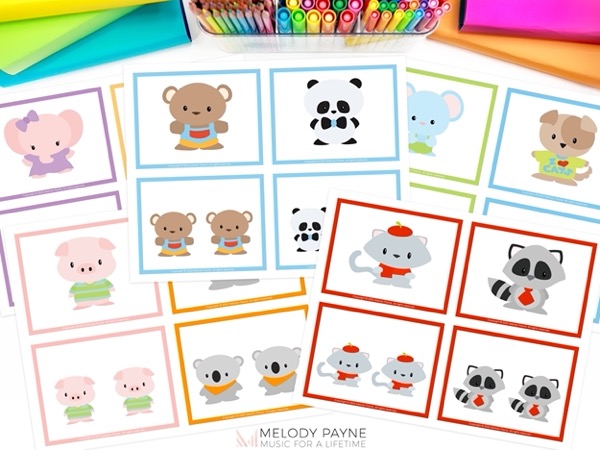
Stage 2: Use the Animal Cards with One Note or Rest (no words)
- I used these cards to teach rhythmic values. As you can imagine, it takes more than one lesson for the student to consistently remember the value of each note. I recommend sticking with these stage cards until the student has mastered learning the note values.
- My approach with each card was something like this: “Let’s see what note the mouse brought!” – and then introduced the note.
- My student asked me to say “Hello” to him using a different voice (pretending to be the animal on the card) before he would engage in the activity, and I was happy to go with the flow. However, if there are certain parents who dislike “talking animals”, then sticking to “Let’s see what X brought” is perfectly reasonable.
Note: When teaching note values, I initially stick to teaching the corresponding rhythm syllables: Ta, Ta-2, Ta-2-3, Ta-2-3-4, and Sh! (for the quarter rest) rather than focusing on having them memorize what each note is called.
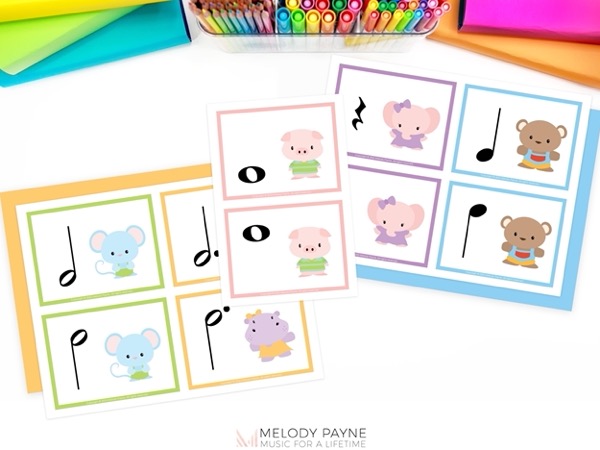
Stage 3: Animal Cards with Notes and Words
- Student taps/claps rhythm syllables first.
- Then substitute rhythm syllables for the word on the card.
- Student can also think of an alternate word that would be appropriate for the rhythm.
- Student creates various color patterns (Stage 1) using these cards; this helps the student get quicker at clapping/tapping rhythm syllables.
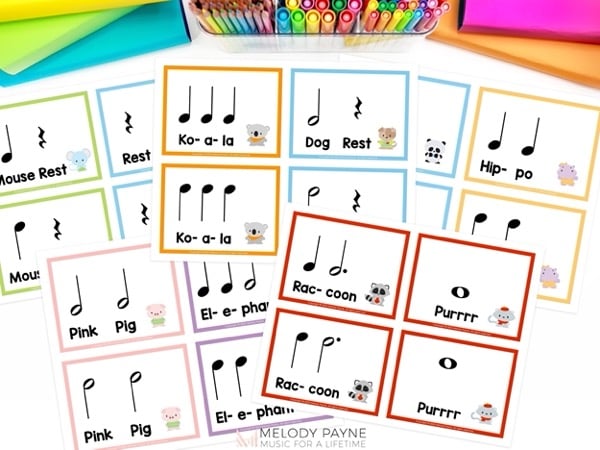
Stage 4: Incorporate Time Signature Cards
- It makes sense to wait to incorporate the time signature cards until after the student has a good grasp of their note values. However, you can incorporate them sooner, upon mastering one stage.

Stage 5: Composition
- The student has the option to compose a variety of compositions with the composition cards.
- Print and cut out a few composition cards and have the student arrange them on their composition page.
- Once the composition is complete, the student can glue the composition cards to their page, or they can rearrange the cards to create another rhythm composition.
- The student should perform each rhythm composition to reinforce the variety of rhythms that have been learned.
- This activity can be repeated as frequently as the student desires.
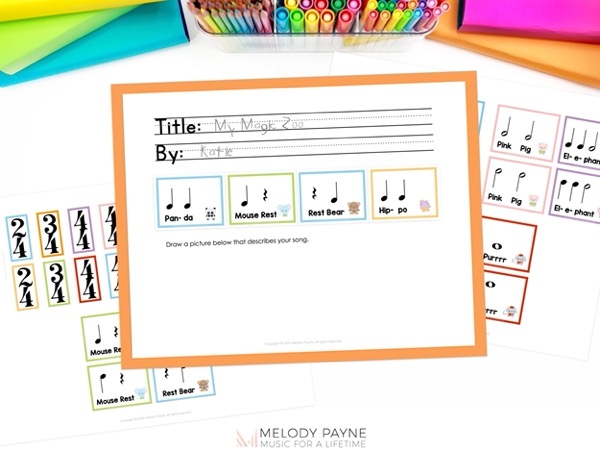
I will add that my student had to feel comfortable with the Stage 1 cards before he suggested we try Stage 2 cards. Be careful not to pace things too fast, and have fun!
I specifically chose to write about these cards because I could instantly see the potential for a wide variety of uses.
If you are brand new to teaching preschool piano lessons, you’ll be glad you purchased these Preschool Rhythm Activity cards to put in your preschool piano teacher toolbox. Give these cards a try at your next trial lesson and be sure to let us know how you liked them!
And in case you were wondering, I use these Complete Color-Coded Flash Cards with the majority of my elementary school-aged students after they have successfully used the preschool rhythm activity cards.
Are you a preschool piano teacher?
If so, how long do you usually work on rhythms? What rhythm activity usually helps your students feel the beat best?
More blog posts to help you teach the little piano students:
- How to Teach Piano Key Geography to Beginning Piano Students
- 5 Tips for Engaging Young Piano Students During Online Lessons
- 9 Essentials to Include in a First Piano Lesson
More worksheets & activities for your piano students:
Don't miss out!
Follow on Facebook and Instagram, join the best Facebook group for piano teachers, and subscribe to the newsletter to get helpful teaching tips, resources, and tutorials delivered straight to your inbox every week.
Michelle Madasamy
Michelle Madasamy
Welcome!
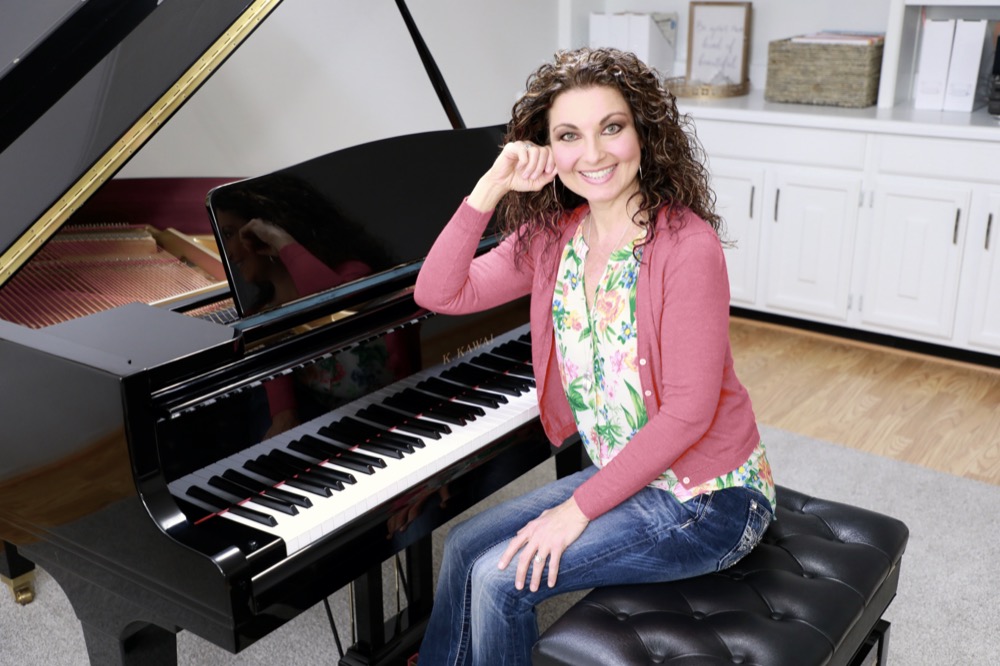
Hi! I’m Melody Payne, a pianist and piano teacher, educational resource author, a fun-loving wife to the most wonderful and talented hubby I could ask for, and a lifelong learner who loves to share. I want to make your life as a music teacher easier by writing and sharing helpful and relevant music teaching articles, and by creating educational resources with your very own students in mind. If you are a parent who wants to enroll your child in piano lessons, I’d love for us to get started building those skills that can give your child a lifetime of musical enjoyment!

